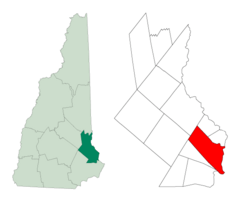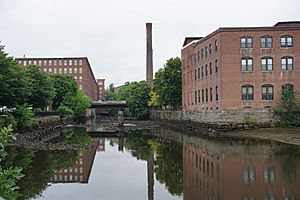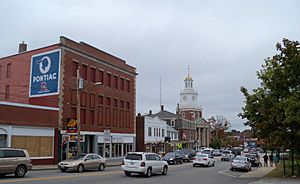Dover, New Hampshire facts for kids
Quick facts for kids
Dover, New Hampshire
|
||
|---|---|---|

City Hall
|
||
|
||
| Nickname(s):
The Garrison City
|
||

Location within New Hampshire
|
||
| Country | United States | |
| State | New Hampshire | |
| County | Strafford | |
| Settled | 1623 | |
| Incorporated | 1623 (town) | |
| Incorporated | 1855 (city) | |
| Area | ||
| • Total | 29.04 sq mi (75.22 km2) | |
| • Land | 26.73 sq mi (69.23 km2) | |
| • Water | 2.31 sq mi (6.00 km2) 7.97% | |
| Elevation | 50 ft (15 m) | |
| Population
(2020)
|
||
| • Total | 32,741 | |
| • Density | 1,224.92/sq mi (472.95/km2) | |
| Time zone | UTC−5 (EST) | |
| • Summer (DST) | UTC−4 (EDT) | |
| ZIP Codes |
03820-03822
|
|
| Area code(s) | 603 | |
| FIPS code | 33-18820 | |
| GNIS feature ID | 0866618 | |
Dover is a city in Strafford County, New Hampshire, in the United States. In 2020, about 32,741 people lived there. This makes it the biggest city in New Hampshire's Seacoast area. It is also the fifth largest city in all of New Hampshire.
Dover is the main city of Strafford County, known as the county seat. It is home to Wentworth-Douglass Hospital, the Woodman Institute Museum, and the Children's Museum of New Hampshire.
Contents
What Does "Dover" Mean?
The city of Dover gets its name from Dover, Kent, a town in England. The word "Dover" comes from an old word meaning "waters." You can see this same word in French ("Douvres") and Welsh ("Dofr").
Dover's History
Early Settlement of Dover
The first European to explore this area was Martin Pring from England in 1603. In 1623, two brothers, William and Edward Hilton, started a settlement called Cochecho Plantation. They used its local Abenaki name.
This made Dover the oldest place where people settled permanently in New Hampshire. It was also the seventh oldest in the entire United States. At first, the area included other towns like Durham and Somersworth.
The Hilton brothers settled near where the Bellamy River and Piscataqua River meet. They were fishmongers sent from London to start a colony and fishery. William Hilton also built a salt works there.
In 1633, a group of English Puritans bought Cochecho Plantation. They wanted to settle in New England. Many new settlers came that year, especially from Bristol, England. They renamed the settlement Bristol. They built a meetinghouse and a jail on a nearby hill.
Becoming a City
In 1637, the new governor, Reverend George Burdett, named the town Dover. It might have been named after Robert Dover, an English lawyer. Later, in 1639, it was briefly renamed Northam.
However, the original English owners lost interest. So, in 1641, the settlement was sold to Massachusetts and was named Dover again.
The early settlers built strong log houses called garrisons. These special houses gave Dover its nickname: "The Garrison City." The town's main center moved from Dover Point to Cochecho Falls. The 34 feet (10 m) drop of the falls provided water power for new industries. "Cochecho" means "the rapid foaming water."
The Cochecho Incident
On June 28, 1689, Dover faced a difficult attack by Native Americans. This event was a response to something that happened in 1676. At that time, Major Richard Waldron had tricked 400 Native American warriors during a "mock battle." After they put down their weapons, they were captured. Some were sent away or sold into slavery.
The Native Americans who were released felt that this trick was a serious break of trust. Thirteen years later, they acted. Fifty-two colonists were either captured or killed. This was about a quarter of Dover's population at the time.
Later, in 1723 and 1724, there were more raids. During one of these, Elizabeth Hanson was captured and later wrote about her experience.
The Mill Era
The Cochecho Falls played a big role in Dover's growth during the 1800s. This was the time of the Industrial Revolution. The Dover Cotton Factory started in 1812. In 1827, the Cocheco Manufacturing Company was founded. They built large brick mills downtown.
Dover officially became a city in 1855. For a while, it was a major producer of textiles (cloth and fabric) in the country.
In 1909, Pacific Mills bought the Dover mills. However, during the Great Depression, many textile mills moved to southern states or closed down. Dover's millyard closed in 1937. The city bought it in 1940 for $54,000. Today, it's called the Cocheco Falls Millworks. It now holds technology companies, government offices, and even a restaurant.
Antique Postcards
-
Cochecho Falls around 1910
Geography and Getting Around
Dover covers about 29 square miles (75.2 square kilometers). Most of this is land, but about 7.97% is water. The city has two rivers, the Cochecho and Bellamy rivers. Both flow into the Piscataqua River, which forms Dover's eastern border. This river also separates New Hampshire from Maine.
The highest point in Dover is Long Hill, which is over 300 feet (91 m) above sea level. Garrison Hill is another important hill right above the city center. It has a park and a lookout tower. The average height above sea level in Dover is about 49 feet (15 m).
Dover is connected by several New Hampshire Routes and U.S. Route 4. It borders towns like Newington, Durham, and Somersworth.
You can get around Dover and nearby towns using the COAST bus network. C&J Bus Lines offers private bus service to Boston and New York City. Wildcat Transit provides bus service to Durham. Amtrak's Downeaster train also stops at the Dover Transportation Center. You can take the train to Portland, Maine, or Boston.
Population Facts
| Historical population | |||
|---|---|---|---|
| Census | Pop. | %± | |
| 1790 | 1,998 | — | |
| 1800 | 2,062 | 3.2% | |
| 1810 | 2,228 | 8.1% | |
| 1820 | 2,871 | 28.9% | |
| 1830 | 5,449 | 89.8% | |
| 1840 | 6,458 | 18.5% | |
| 1850 | 8,196 | 26.9% | |
| 1860 | 8,502 | 3.7% | |
| 1870 | 9,294 | 9.3% | |
| 1880 | 11,687 | 25.7% | |
| 1890 | 12,790 | 9.4% | |
| 1900 | 13,207 | 3.3% | |
| 1910 | 13,247 | 0.3% | |
| 1920 | 13,029 | −1.6% | |
| 1930 | 13,573 | 4.2% | |
| 1940 | 13,990 | 3.1% | |
| 1950 | 15,874 | 13.5% | |
| 1960 | 19,131 | 20.5% | |
| 1970 | 20,850 | 9.0% | |
| 1980 | 22,377 | 7.3% | |
| 1990 | 25,042 | 11.9% | |
| 2000 | 26,884 | 7.4% | |
| 2010 | 29,987 | 11.5% | |
| 2020 | 32,741 | 9.2% | |
| 2022 (est.) | 33,416 | 11.4% | |
| U.S. Decennial Census | |||
In 2020, Dover had 32,741 people living there. The city grew by over 2,700 residents between 2010 and 2020. This was the third-largest growth for a city in New Hampshire.
Most people in Dover (about 87.2%) are White. About 5.1% are Asian, and 1.7% are African American. About 2.9% of the population is Hispanic or Latino.
In 2009–2011, the average yearly income for a family in Dover was about $69,980. About 8.9% of the people in Dover lived below the poverty line. This included 13.2% of those under 18 years old.
Education in Dover
The Dover School District serves about 4,000 students. They attend schools like Horne Street Elementary, Garrison Elementary, Woodman Park Elementary, Dover Middle School, and Dover High School. Dover High's sports teams are called "The Green Wave."
Saint Mary Academy is a Catholic school in downtown Dover. It has been there since 1912 and teaches students from pre-kindergarten to 8th grade. Many students then go to St. Thomas Aquinas High School, another Catholic high school.
Portsmouth Christian Academy is also in Dover. It serves students from preschool through 12th grade.
The Cocheco Arts and Technology Academy (CATA) is a public charter high school with about 100 students. The Seacoast Charter School is a publicly funded elementary/middle school. It focuses on including the arts in its lessons.
Notable People from Dover
Historic Sites to See
- First Parish Church
- New Hampshire Historical Marker No. 51: Dr. Jeremy Belknap (1744–1798)
- New Hampshire Historical Marker No. 92: Hilton's Point – 1623
- New Hampshire Historical Marker No. 165: The Alexander Scammell Bridge over the Bellamy River
- New Hampshire Historical Marker No. 264: Home of John Parker Hale, 1840–1873
- New Hampshire Historical Marker No. 282: Native Retribution Against Maj. Waldron
- New Hampshire Historical Marker No. 289: Creation of the Teenage Mutant Ninja Turtles
- Religious Society of Friends Meetinghouse
- St. Thomas Episcopal Church
- Woodman Institute
See also
 In Spanish: Dover (Nuevo Hampshire) para niños
In Spanish: Dover (Nuevo Hampshire) para niños














